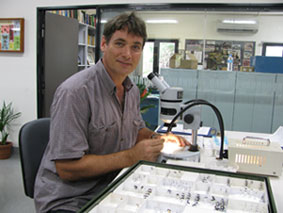 Land managers are increasingly looking for reliable indicators of ecosystem health and biodiversity change that can be used to assess the ecological sustainability of land management practices. Throughout the world, invertebrates are often used for this purpose because they are so diverse and play such crucial roles in the functioning of ecosystems; if an ecosystem's invertebrates are in good shape, then this indicates that the ecosystem in general is in good shape. In Australia, ants are the most widely used invertebrate indicators in land management.
Land managers are increasingly looking for reliable indicators of ecosystem health and biodiversity change that can be used to assess the ecological sustainability of land management practices. Throughout the world, invertebrates are often used for this purpose because they are so diverse and play such crucial roles in the functioning of ecosystems; if an ecosystem's invertebrates are in good shape, then this indicates that the ecosystem in general is in good shape. In Australia, ants are the most widely used invertebrate indicators in land management.
Dr. Alan Andersen, Chief Research Scientist with CSIRO's Tropical Ecosystems Research Centre in Darwin, is widely recognized as the world's leading expert on the ecology of ants, which are the world's dominant faunal group in terms of biomass (ants represent about 30% of the global biomass of terrestrial fauna) and ecological function. His most significant contribution has been the development of an innovative model of ant community structure based on functional groups in relation to environmental stress and disturbance. This model allows the prediction globally of ant community structure in relation to climate, vegetation and land-use, and is routinely adopted by ecologists throughout the world as a basis for understanding the dynamics of ant communities. Alan has applied this understanding to the use of ants as bio-indicators in land management. As well as developing a predictive understanding of the responses of ant communities to land-use, he has documented the extent to which ant responses reflect general ecological change, and developed innovative protocols for the efficient sampling of ants in environmental monitoring. He received the 2001 South-East Asian Innovation Award for this work. His research has been instrumental in ants being the invertebrate indicator of choice in land management throughout Australia and overseas. His work directly led to South Africa's Kruger National Park establishing a comprehensive ant monitoring program, which is now being rolled out throughout the South African National Parks system.



